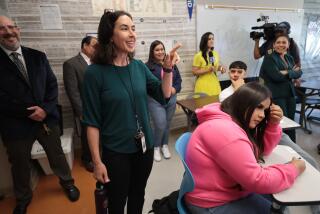District’s dance of death
- Share via
They’re doing the dance again -- the soul-sapping, time-wasting annual ritual of figuring out how many of society’s most important public servants to push off a cliff.
RIF season, some call it, for Reduction in Force.
This year, Los Angeles Unified is going for the gold. An astounding 9,500 teachers, nurses and human services employees have been notified by mail that their jobs are on the line, as well as 2,000 administrators. Nowhere near that number will be laid off in the end, but the law requires that teachers be notified of the possibility of impending doom long before budgets are set. And so, year after year, we go through this maddening, disruptive and costly process.
On Monday, I sat with seven long-faced teachers on the third floor of a building near downtown L.A. They were there to make the case before an administrative law judge (who charges L.A. Unified by the hour) that although they stand to lose their current jobs, they have enough experience and seniority to require that they be transferred to different posts in the district rather than be laid off.
All but one of these teachers prevailed in the end, but they were missing school for this, and they all looked like they had the pride pounded out of them. Where will they end up next year? It’s anyone’s guess. And if they’re transferred, it means learning a whole new set of students and parents, developing new collaborations with teachers and getting to know a new principal.
Alberta Henderson is in her ninth year at 74th Street Elementary School. She told me she loves everything about her school and about teaching third grade, and she doesn’t want to leave. But she got RIFed. She’s certified to teach high school, and if she wants to keep eating, she’ll have to take a transfer and bounce someone else out of work.
“I was never suicidal,” said another teacher, who asked to remain anonymous. But she said the annual threat of losing her job and the blow to morale that comes from being so undervalued, “makes you want to end it all.”
In the room where she waited was a partial list of those who got RIFed: 95 art teachers, 327 counselors, 66 music teachers, 111 phys ed teachers, 183 psychologists, 133 social studies teachers, 31 nurses, 27 computer science teachers and that’s just the beginning.
Last year, my colleague Hector Tobar detailed the particularly ghastly interrogation of teacher-librarians who were called to the stand by district lawyers who wondered whether they really knew anything about teaching. The librarians were being forced to prove whether, if their positions were eliminated, they were competent to return to a classroom.
This year, 50 teacher-librarians got RIFed and several have gone before the kangaroo court to fight for a chance to keep working, in a classroom if not in a library. One of them, Hamilton High librarian Rosemarie Bernier, took the stand Monday after telling me how horrible and demeaning it had been to be grilled about her qualifications a year earlier by district attorneys.
She’s been at Hamilton since 1997, sees several hundred students daily, helps them find books and teaches them how to use trusted databases when doing research. She also collaborates with other teachers on lesson plans. The idea that technology makes libraries and librarians obsolete is absurd, said Bernier.
“They don’t know how to use technology” to full educational benefit, she argued, and I guess I should remind readers that I’m in full agreement -- and also the father of a college librarian.
On the stand, Bernier -- a national board-certified teacher and past president of the California Library Assn. -- was asked questions by a union attorney in the interest of sparing her harsher treatment from district attorneys.
“Do you give assignments, homework, tests, quizzes and grade all the work they do?”
Bernier kept answering in the affirmative, but suddenly the district lawyers interrupted to say there’d been a development, and Bernier’s RIF notice was being rescinded.
A development?
This is how screwball the process is. A librarian is forced to leave school, drive downtown to try to save her job, and when they’ve got her on the hot seat, the district says never mind. As it turned out, Bernier was No. 52 on a seniority list, and the current plan is to limit layoffs to 50 teacher-librarians.
But that’s subject to change, of course, because the only certainty about school budgets is that they’re always changing, and by changing, I mean shrinking.
This is not the fault of L.A. Unified, which is at the mercy of the state’s revenue roller-coaster and has had to slash its budget like other districts. It’s fair to question the district’s leadership, spending priorities and emphasis on revenue-sucking charter schools, just as it’s fair to ask whether the unions could make more compromises on work rules and benefits.
But there has to be a saner way to fund and operate the state’s public schools, and for me, Gov. Jerry Brown’s proposal to hike income and sales taxes -- in part for the benefit of schools --- is an uninspired Band-aid approach that fixes none of the underlying problems.
One of many recommendations of California Forward, established to think big about reform, was to lower some corporate and personal income taxes while raising as much as $10 billion a year in additional revenue through a service tax. Half the state’s $2-trillion economy is in services that aren’t taxed, explained committee co-chair Bob Hertzberg. We pay a tax on a doughnut, but not on accounting, legal work and other services.
Most of that $10 billion would be plowed into K-12 and higher education, said Hertzberg, who also recommended breaking L.A. Unified into smaller districts more aligned with city neighborhoods. Let your imagination run a little, Hertzberg said, and the school down the street could become the neighborhood library, rec center, vocational skills center, social hall and city hall, with savings to be had in the elimination of duplicated services. Schools and neighborhoods can only benefit when interests are aligned, said Hertzberg, who’s been preaching this vision for several years.
A long shot, to say the least. But in the midst of yet another funeral dance, with teaching jobs on the block and millions of children’s futures at stake, it’s time to think differently and maybe even dream a little.
--
More to Read
Sign up for Essential California
The most important California stories and recommendations in your inbox every morning.
You may occasionally receive promotional content from the Los Angeles Times.














